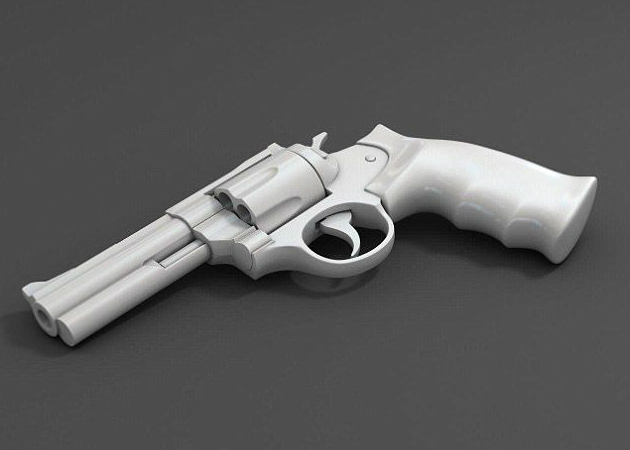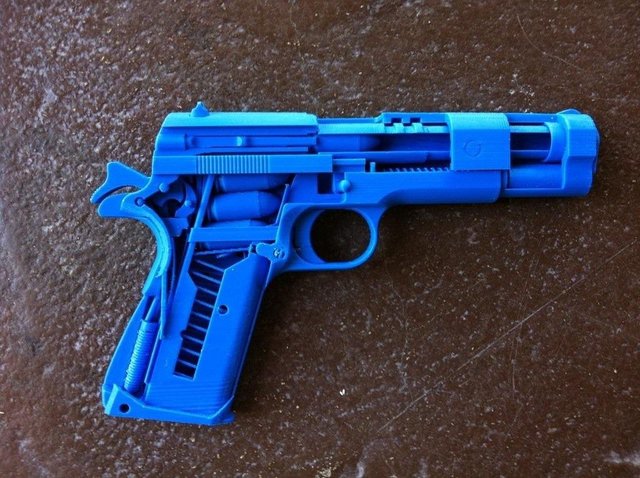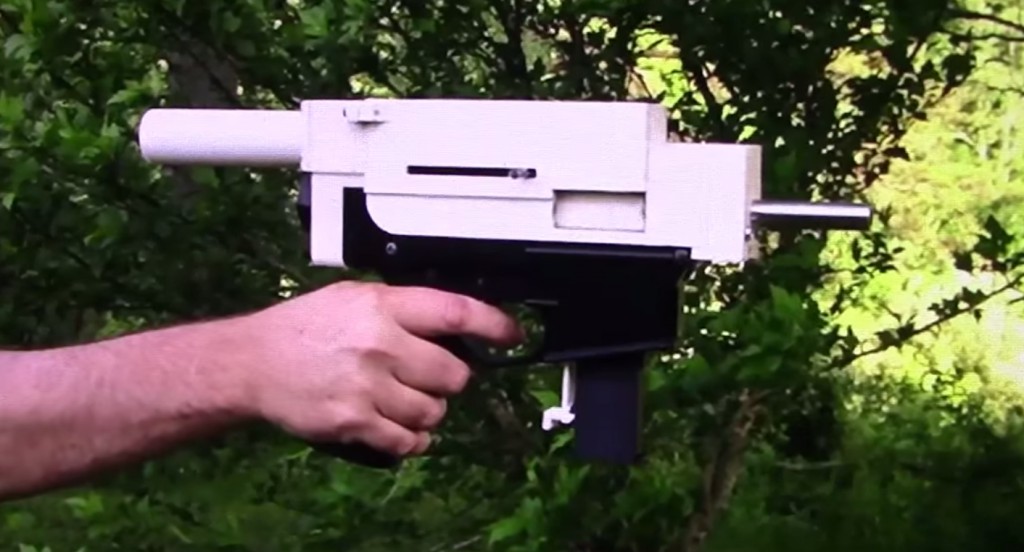- if the person isn't a US citizen and cant buy them easily.
- completely untraceable
- a method around restrictive gun legislation.
- unlimited copies. Purchasing a gun is cheaper. Nevertheless printers are already much more affordable then even 2 years back.
- uploading a file to your 3d printer is much easier then machining one yourself
- felon or offender not allowed to buy a gun
Lots of movies of folks putting more two 30 round magazines thru a gun. It is enough to be thrown off with no means of traceability and harmful, although yes, it is not going to become a gun passed down generations.

(Credit: Pinterest)
This is the reason that in any offenses it hasn't been used despite the documents for the Liberator being available for three decades, as well as my knowledge no one has ever been hurt or killed with you. That doesn't mean that I would like to be shot with a 3D printed gun, of course it might be used to hurt or kill somebody. But so far the people who have tools and the ability to make 3D printed firearms aren't the people who we will need to worry about damaging or killing anybody. The simple fact is at this point they aren't a problem, even though there's plenty of room to debate how much we should attempt to control or regulate 3D guns. Anyone who brings up 3D guns while discussing gun control or curbing mass killings is doing so as a tactic that is derailing, not because they are relevant to this discussion.
The type of substances used with an FDM 3D printer are referred to. They are a type of plastic that become a liquid or pliable when chilled will solidify without becoming altered at all or weakened, and yet when heated. We use thermoplastics in only about every consumer product that you'll find in your home, from the casing to your control to the mouse which you're using to the dishes in your own kitchen to the case in your smartphone with your computer. There are dozens of different kinds of thermoplastics that have been specially formulated to work with an FDM 3D printer, but the two most commonly used substances are Polylactic Acid (PLA) and Acrylonitrile Butadiene Styrene (ABS).

(Credit:LiveJournal)
The Shuty handgun is created from 3D printed parts and both firearm parts.
Yes, metal yes it may be utilized to 3D, and 3D printing technologies is real publish the parts to get a functional firearm. There are a number of metallic 3D printing processes and technologies, but what they all have in common is cost. A metallic 3D printer will probably cost tens of thousands if not hundreds of thousands of dollars, so using it to 3D print a gun isn't going to be anywhere near cheap. Actually, a few years back a company actually did utilize a metallic 3D printer to create a gun, and Solid Concepts (now part of Stratasys Direct and no longer in the gun business) sold them for $11,000 a bit. If you're a criminal trying to commit a crime using a gun, then just how is it that you are likely to invest 11 grand to produce your own gun as opposed to go purchase one for under $300 in a gun show? Simply because it is possible doesn't mean that it is likely to happen.
What I hope all of this demonstrates is that creating a 3D printed gun isn't simple, it is not quick, it is not cheap and it does not result in especially dangerous or lethal weapons. Not only can it be cheaper to just get a gun from the United States, but it is likely to go purchase one, even with any state-mandated waiting intervals. In countries such as Japan, the UK or Germany, that have very strict gun control legislation, 3D printed firearms haven't been used to commit a serious offense or used as a viable option to traditional guns that were illegally purchased. Australia is on the lookout for 3D printed guns, targeting them with legislation, but even there it is a precaution, not a response. If you're looking to use in a crime, there are just a lot of different alternatives available before you even get to using a 3D printer. And it is if you can purchase a fundamental 3D printer and print yourself a few guns in a few hours. While you don't need to level to utilize a 3D printer it will take.
The most typical sort of 3D printing is the procedure called Fused Deposition Modelling (FDM), and this tech is the primary method used to earn the handful of functioning 3D printed firearms that were made. The process works by slicing an electronic file referred to as a 3D model into dozens, sometimes hundreds of thin, on average about .1 mm thick, layers. The 3D printer will then utilize precision to replicate these individual slices each using thermoplastics, 1 coating. The end result will be a complete copy of the file. Based on how big the part, the sort of material being used and the version of 3D printer, this procedure can take several hours.

(Credit: 21stcentech)
When there are many hybrid gun layouts around that incorporate 3D printed components with real, metal gun components, let us be honest no one will construct their own guns to commit crimes. They are unworthy for sneaking past any security, since these hybrids contain metal components and they are bulkier so they'd be much more difficult to conceal. As soon as you can just go buy a new one, and again, why build a gun? And it isn't even though it's currently prohibited to build your guns using conventional methods. There is really a large community of custom gun makers having the machinery and ability to make any firearm that they could possibly want, and there are not a lot of mass murderers that have used handmade firearms. Employing 3D components to construct your guns is different than milling them yourself. In fact, also a CNC mill along with a 3D printer are two very technology that are similar.
It's simply not feasible to check out the numbers of gun deaths in our nation and ignore the fact that we have a problem with gun violence that needs to be taken care of. While I certainly have my comments, I ca tell you the method to suppress killings without subverting our Constitution or the rights of responsible and lawful gun owners. I don't understand, and as a nation we need to locate a common middle ground that we can all live with. However, what I can tell youpersonally, and what I do know, is that 3D guns are not part of the problem and you shouldn't let anyone convince you that they are. The kind of guns chosen by men and women who commit heinous crimes and mass killings are picked for their ability to kill as many people as possible as quickly as possible, and that I hope that at the very least we can all now agree that nobody will find a weapon such as that by a 3D printer. What are your thoughts on this topic? Please discuss them with us at the 3D Printed Weapons discussion over at 3DPB. com.
There are limitations to as an FDM 3D printer is currently functioning with plastic. A 3D printer can't create a complex mechanism such as a gun that is functional all. Rather, each distinct component of the gun needs to be 3D printed individually and later constructed. Additionally, if any of those components' shape has an overhang of more than approximately 45 degrees, then in order for the part it needs to incorporate some kind of support structures which will need to be removed. Even then, the geometries of some components will be too complex to 3D print. These limitations make 3D printing a functional gun time consuming and hard, and a reason is that there has really only been a genuinely viable gun designs that are printable.
Yes, this was 3D. This also cost 11 grand.

(Credit: Pinterest)
PLA tends to be softer, therefore it is not as strong or lasting as ABS, however it has more "give" and is more pliable. A component will probably bend and deform before it shatters or breaks. While ABS is significantly tougher and stronger after it reaches its limitations it has a tendency to crack and break rather than deform. The fact is that neither material lends itself especially well to something as complex as a weapon. 3D printed firearms are normally made with ABS, but even with the material you will only be able to fire one shot before a part breaks or fails and needs to be replaced. The force of shooting a bullet is too strong for thermoplastics to survive.

(Credit: 3dhoo)
Hi! I am a robot. I just upvoted you! I found similar content that readers might be interested in:
https://3dprint.com/139537/3d-printed-guns/
Downvoting a post can decrease pending rewards and make it less visible. Common reasons:
Submit
While quite a bit of the rest of your post is reasonable, this isn't even on a nodding acquaintance with reality. PLA is more brittle than ABS, and it's made of polylactic acid – so while it might eventually break down more readily if exposed to long-term UV, outside of that context it is certainly as lasting as ABS.
"Strong" is wrong on a different axis. PLA tends to shatter under force, while ABS deforms – before shattering. ABS is nylon, after all, and we have a pretty good grasp of how nylon performs under load.
It is theoretically possible to create an FDM-deposited receiver for a firearm that doesn't shatter on the first shot. The resulting design wouldn't look like a traditional design at all, and there's really not much interest in doing so – because it is so easy to make machined gun parts from lightweight aluminum on a CNC machine.
But no one talks about banning CNC machines. Probably for the best, because then there would be no small machinist shops on the continent.
Downvoting a post can decrease pending rewards and make it less visible. Common reasons:
Submit